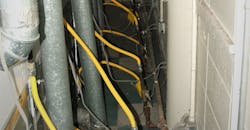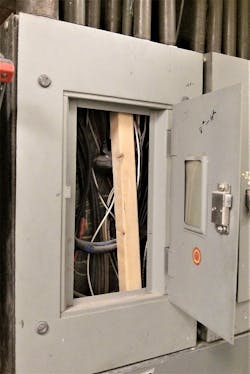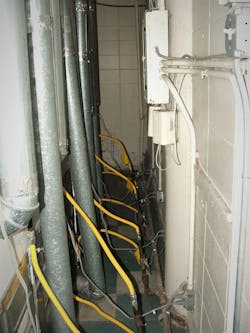A Surprise Behind Door No. 1
I’m not sure that shoving a 2×4 board inside an electrical enclosure is such a good idea. It appears this installer made some “field modifications” to a panelboard cabinet by ripping out its guts and using the enclosure as a splice box. Apparently, there was too much tension on the conductors and splices for them to sit nice and flush inside the cabinet, so a combustible piece of wood was used as a “brace” to hold the conductors in place. Using an old panelboard cabinet in this manner could be considered a violation of Sec. 110.3(B) because this equipment was not designed and listed for this use. If there is simply not enough space for the conductors and splices to fit, perhaps this enclosure does not comply with the space requirements of Sec. 312.7. Or, maybe we should consider Art. 314 violations since this seems to be a “junction box” rather than a “cabinet” now. Perhaps this “splice box” is not correctly sized to the requirements of Sec. 314.28(A)(2). In any case, there could be real trouble if any splices start arcing and cause this 2×4 to ignite.
Time to Air Some Dirty Laundry
The view in this photo is from behind a row of washing machines and gas dryers in the laundry room of an apartment building. The dryer vent pipes can be seen on the left side. The yellow gas piping connections can be seen along the entire floor area behind these machines. The big problem is getting to the panelboard, which is located high on the right-side wall. How in the world is anyone supposed to safely work on this panelboard? It’s simply impossible. Which do you think is worse? Stepping on a gas line and causing a massive gas leak, or accidently grounding yourself and getting electrocuted while trying to work in this space? I think the combination of getting shocked and causing a gas leak would be the worst. This panelboard must be relocated to create a safer work space — one that would comply with the depth, width, and height requirements of Sec. 110.26(A). One more violation I can point out is the gas pipe being located directly below the panelboard. This clearly violates the “dedicated space” requirements found in Sec. 110.26(E).
About the Author

Russ LeBlanc
Owner
Russ started in the electrical trade as an apprentice in 1985. He worked his way up to become a Journeyman Electrician and then eventually became a Master Electrician and Licensed Construction Supervisor. In 1999 Russ become an Electrical Instructor for The Peterson School of Engineering in Massachusetts where he developed his passion for teaching, and quickly became Department Head of Electrical Instruction. Russ has taught thousands of apprentices, electricians, engineers, inspectors, and other electrical professionals during his career as an instructor. He continues to provide electrical professionals with Electrical Code seminars, Arc-Flash Awareness training seminars and educational material through his LeBlanc Consulting Services in North Reading, MA whose specialty is educating electricians. He has been an active member of the NFPA Electrical Section and has authored hundreds of National Electrical Code proposals and comments which have become Code rules to improve the safety for the electrical industry. Russ is also an IAEI certified Electrical Inspector.
Please visit www.russleblanc.net for more information.


